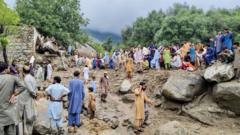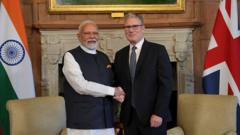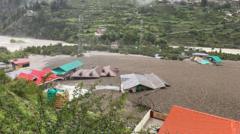The recent military clash between India and Pakistan saw a surge in misinformation, with even reputable media outlets reporting fabricated stories and unverified accounts of military successes, sparking concerns about the erosion of journalistic standards.
The Role of Media in Escalating Misinformation During the India-Pakistan Conflict

The Role of Media in Escalating Misinformation During the India-Pakistan Conflict
A deep dive into how trusted news outlets in India amplified unverified claims during a recent military confrontation with Pakistan, raising concerns about journalistic integrity.
In a time of conflict, the dissemination of accurate information is more crucial than ever. However, a recent four-day military confrontation between India and Pakistan unveiled a concerning trend as credible news outlets succumbed to the pressure of rapid reporting, ultimately amplifying misinformation. Reports emerged claiming that the Indian military had launched significant strikes against strategic locations in Pakistan, including a supposed attack on a nuclear base and the sinking of Pakistani naval vessels. Each of these claims, while detailed, was unsubstantiated.
During the conflict, a wave of disinformation permeated social media, rife with half-truths and manipulated narratives. The overwhelming amount of misleading content blurred the lines between truth and fiction, leaving analysts struggling to sift through the chaos. While the prevalence of misinformation online is not new, the involvement of previously trusted media figures and networks is alarmingly novel, as observed by experts on misinformation such as Sumitra Badrinathan.
Badrinathan, an assistant professor of political science, emphasized that the source of misinformation has shifted; it is no longer just anonymous accounts or bots. Instead, established journalists and news outlets are being drawn into sharing fabricated stories, leading to a crisis of trust in the media. In fact, she noted, a key issue arises when sources that audiences once relied on for accurate reporting become vehicles for disinformation.
As the situation evolves, there is growing concern about the implications of media complicity in the spread of misinformation, particularly in the context of two nuclear-armed nations. In an era where sensationalism frequently overrides accuracy, the responsibility lies with media professionals to maintain journalistic integrity, ensuring their platforms do not inadvertently fuel conflict.
The Indian media landscape faces critical scrutiny as examples of unverified information emerge alongside calls for greater accountability in reporting. In an environment characterized by heightened nationalism, the stakes for correct reporting are incredibly high, and the ramifications of misinformation can resonate far beyond the newsroom.
During the conflict, a wave of disinformation permeated social media, rife with half-truths and manipulated narratives. The overwhelming amount of misleading content blurred the lines between truth and fiction, leaving analysts struggling to sift through the chaos. While the prevalence of misinformation online is not new, the involvement of previously trusted media figures and networks is alarmingly novel, as observed by experts on misinformation such as Sumitra Badrinathan.
Badrinathan, an assistant professor of political science, emphasized that the source of misinformation has shifted; it is no longer just anonymous accounts or bots. Instead, established journalists and news outlets are being drawn into sharing fabricated stories, leading to a crisis of trust in the media. In fact, she noted, a key issue arises when sources that audiences once relied on for accurate reporting become vehicles for disinformation.
As the situation evolves, there is growing concern about the implications of media complicity in the spread of misinformation, particularly in the context of two nuclear-armed nations. In an era where sensationalism frequently overrides accuracy, the responsibility lies with media professionals to maintain journalistic integrity, ensuring their platforms do not inadvertently fuel conflict.
The Indian media landscape faces critical scrutiny as examples of unverified information emerge alongside calls for greater accountability in reporting. In an environment characterized by heightened nationalism, the stakes for correct reporting are incredibly high, and the ramifications of misinformation can resonate far beyond the newsroom.























